Employability Skills Report: Strategies for Tesco Employees
VerifiedAdded on 2019/12/03
|10
|2696
|422
Report
AI Summary
This report comprehensively examines employability skills, focusing on decision-making processes, interpersonal communication, and time management strategies within a business context. It begins by outlining the steps involved in effective decision-making, emphasizing information gathering, evaluation of alternatives, and execution of decisions, followed by an analysis of five crucial interpersonal skills: verbal communication, listening skills, negotiation, problem-solving, and decision-making. The report then delves into communication techniques used at Tesco, including emails, meetings, and presentations, highlighting their effectiveness. Furthermore, it explores various time management strategies, recommending the prioritization technique. Finally, the report introduces an alternative strategy, structuralist strategies, designed to enhance employee efficiency and market share for Tesco by clearly defining roles and responsibilities.
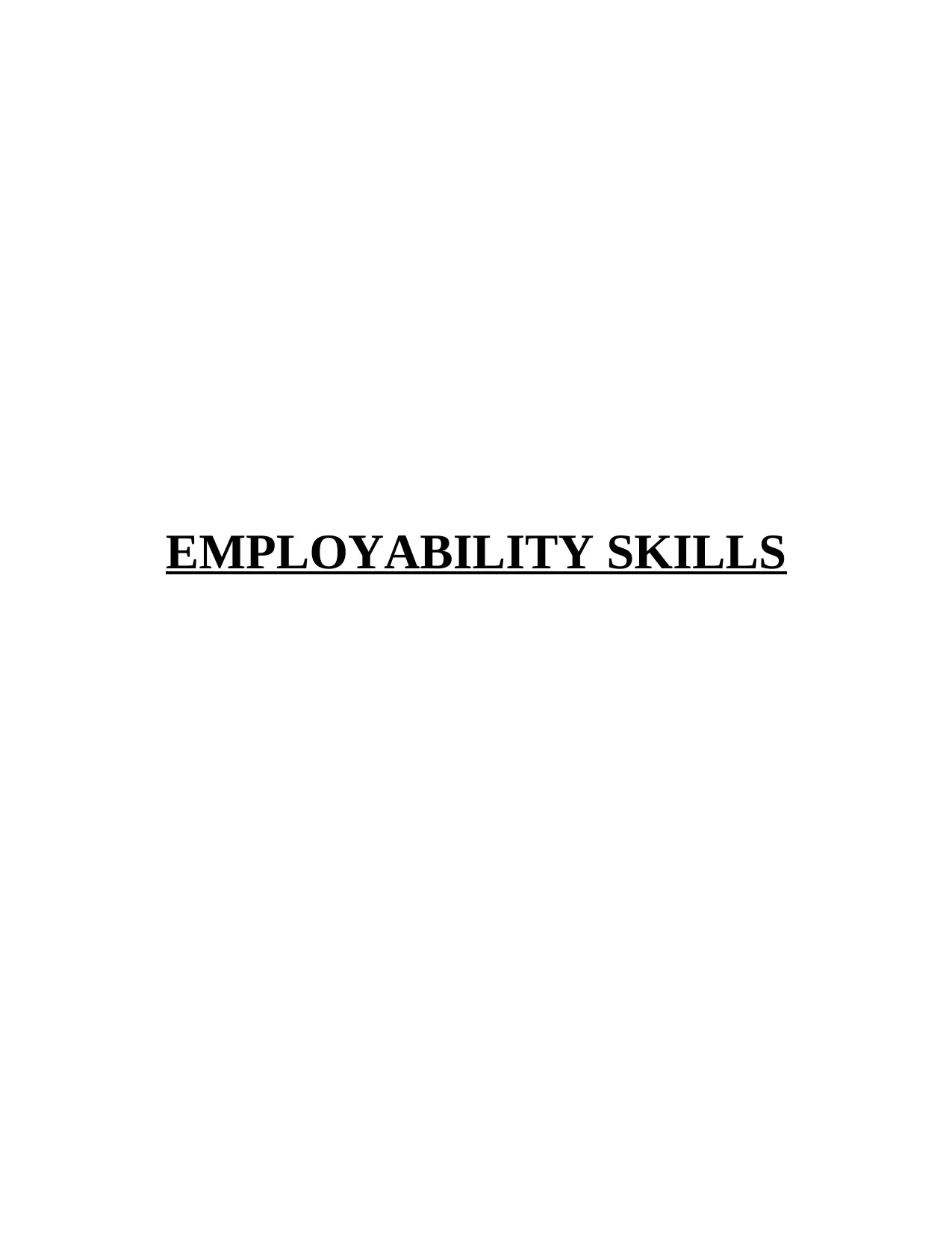
EMPLOYABILITY SKILLS
Paraphrase This Document
Need a fresh take? Get an instant paraphrase of this document with our AI Paraphraser
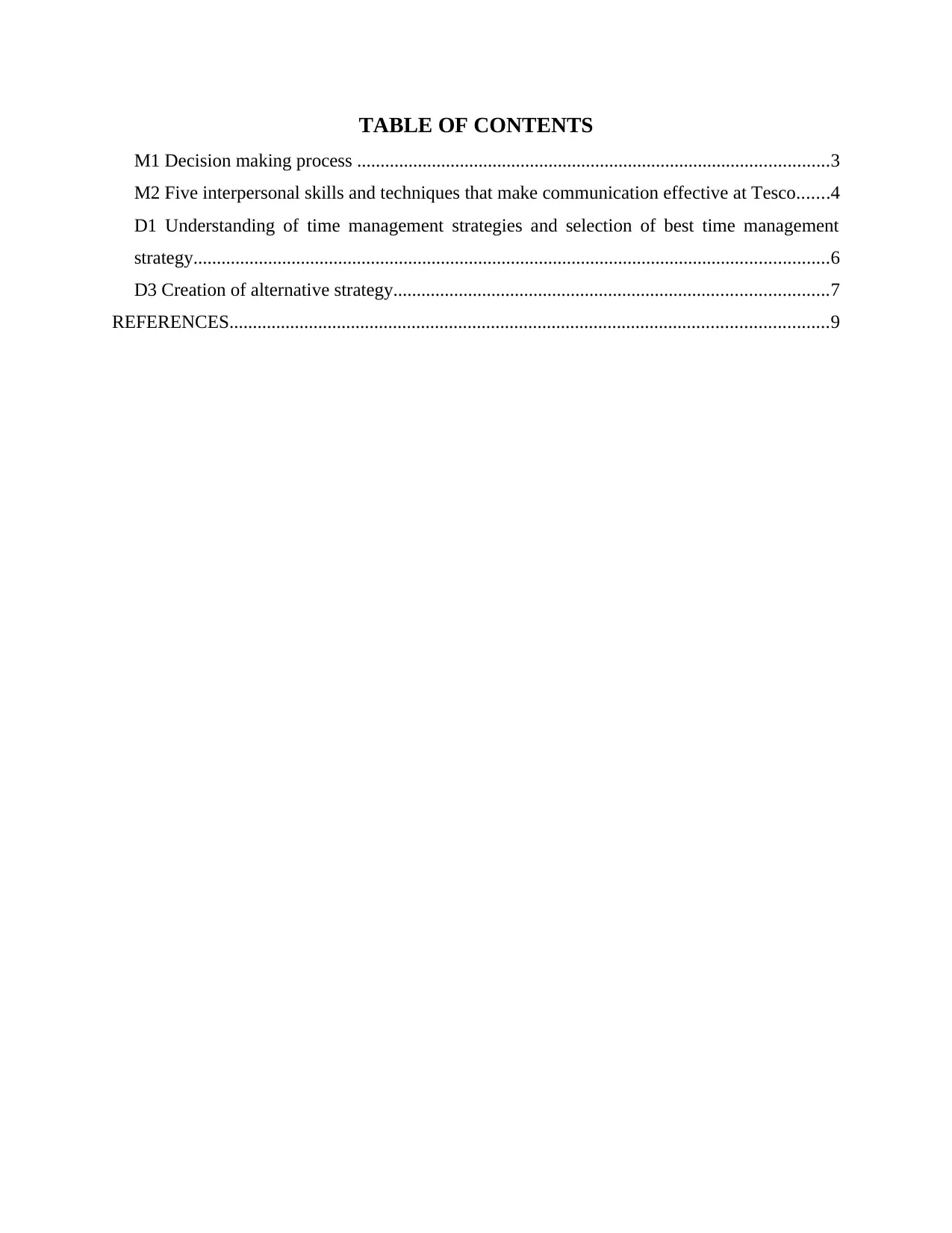
TABLE OF CONTENTS
M1 Decision making process .....................................................................................................3
M2 Five interpersonal skills and techniques that make communication effective at Tesco.......4
D1 Understanding of time management strategies and selection of best time management
strategy........................................................................................................................................6
D3 Creation of alternative strategy.............................................................................................7
REFERENCES................................................................................................................................9
M1 Decision making process .....................................................................................................3
M2 Five interpersonal skills and techniques that make communication effective at Tesco.......4
D1 Understanding of time management strategies and selection of best time management
strategy........................................................................................................................................6
D3 Creation of alternative strategy.............................................................................................7
REFERENCES................................................................................................................................9
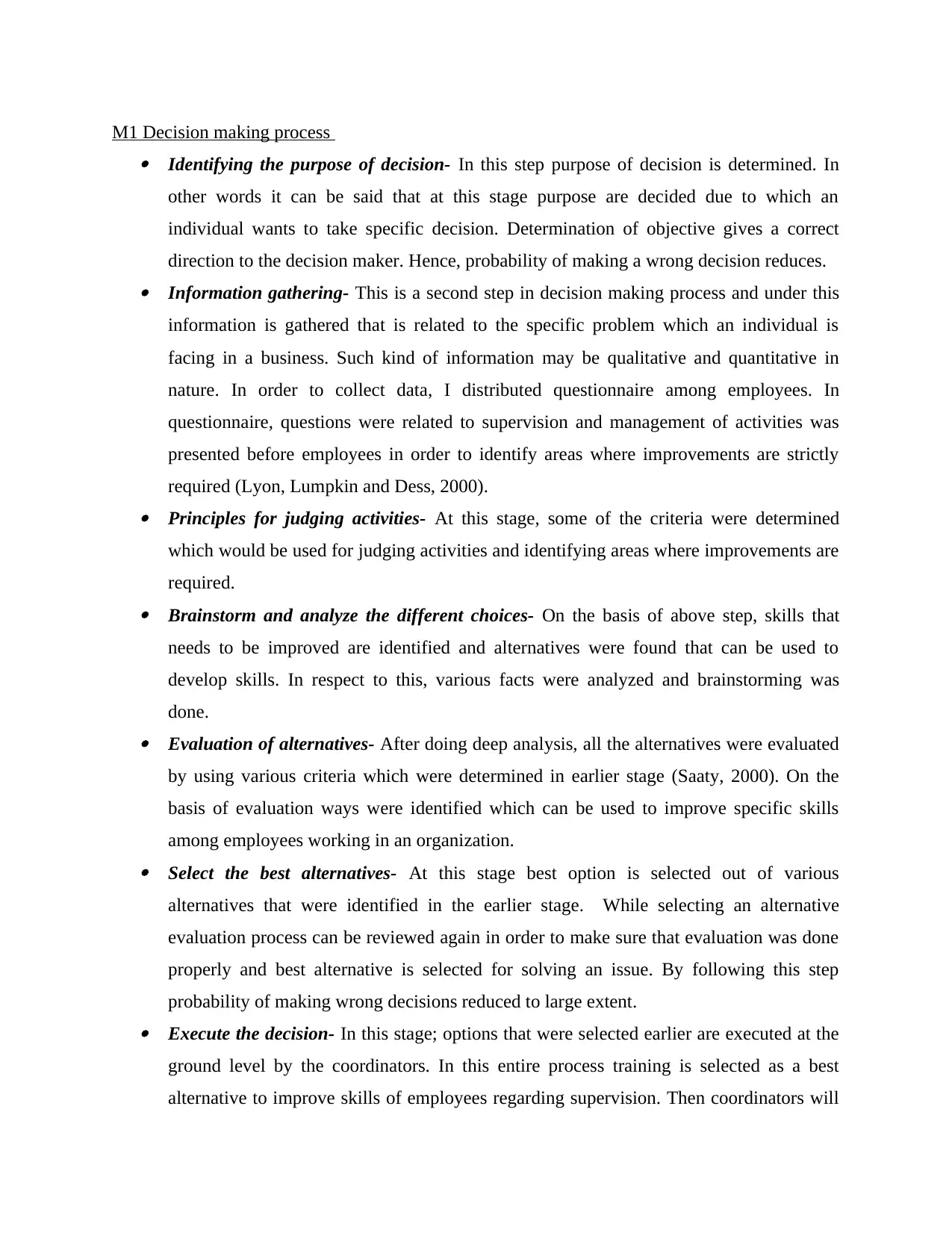
M1 Decision making process Identifying the purpose of decision- In this step purpose of decision is determined. In
other words it can be said that at this stage purpose are decided due to which an
individual wants to take specific decision. Determination of objective gives a correct
direction to the decision maker. Hence, probability of making a wrong decision reduces. Information gathering- This is a second step in decision making process and under this
information is gathered that is related to the specific problem which an individual is
facing in a business. Such kind of information may be qualitative and quantitative in
nature. In order to collect data, I distributed questionnaire among employees. In
questionnaire, questions were related to supervision and management of activities was
presented before employees in order to identify areas where improvements are strictly
required (Lyon, Lumpkin and Dess, 2000). Principles for judging activities- At this stage, some of the criteria were determined
which would be used for judging activities and identifying areas where improvements are
required. Brainstorm and analyze the different choices- On the basis of above step, skills that
needs to be improved are identified and alternatives were found that can be used to
develop skills. In respect to this, various facts were analyzed and brainstorming was
done. Evaluation of alternatives- After doing deep analysis, all the alternatives were evaluated
by using various criteria which were determined in earlier stage (Saaty, 2000). On the
basis of evaluation ways were identified which can be used to improve specific skills
among employees working in an organization. Select the best alternatives- At this stage best option is selected out of various
alternatives that were identified in the earlier stage. While selecting an alternative
evaluation process can be reviewed again in order to make sure that evaluation was done
properly and best alternative is selected for solving an issue. By following this step
probability of making wrong decisions reduced to large extent. Execute the decision- In this stage; options that were selected earlier are executed at the
ground level by the coordinators. In this entire process training is selected as a best
alternative to improve skills of employees regarding supervision. Then coordinators will
other words it can be said that at this stage purpose are decided due to which an
individual wants to take specific decision. Determination of objective gives a correct
direction to the decision maker. Hence, probability of making a wrong decision reduces. Information gathering- This is a second step in decision making process and under this
information is gathered that is related to the specific problem which an individual is
facing in a business. Such kind of information may be qualitative and quantitative in
nature. In order to collect data, I distributed questionnaire among employees. In
questionnaire, questions were related to supervision and management of activities was
presented before employees in order to identify areas where improvements are strictly
required (Lyon, Lumpkin and Dess, 2000). Principles for judging activities- At this stage, some of the criteria were determined
which would be used for judging activities and identifying areas where improvements are
required. Brainstorm and analyze the different choices- On the basis of above step, skills that
needs to be improved are identified and alternatives were found that can be used to
develop skills. In respect to this, various facts were analyzed and brainstorming was
done. Evaluation of alternatives- After doing deep analysis, all the alternatives were evaluated
by using various criteria which were determined in earlier stage (Saaty, 2000). On the
basis of evaluation ways were identified which can be used to improve specific skills
among employees working in an organization. Select the best alternatives- At this stage best option is selected out of various
alternatives that were identified in the earlier stage. While selecting an alternative
evaluation process can be reviewed again in order to make sure that evaluation was done
properly and best alternative is selected for solving an issue. By following this step
probability of making wrong decisions reduced to large extent. Execute the decision- In this stage; options that were selected earlier are executed at the
ground level by the coordinators. In this entire process training is selected as a best
alternative to improve skills of employees regarding supervision. Then coordinators will
⊘ This is a preview!⊘
Do you want full access?
Subscribe today to unlock all pages.

Trusted by 1+ million students worldwide
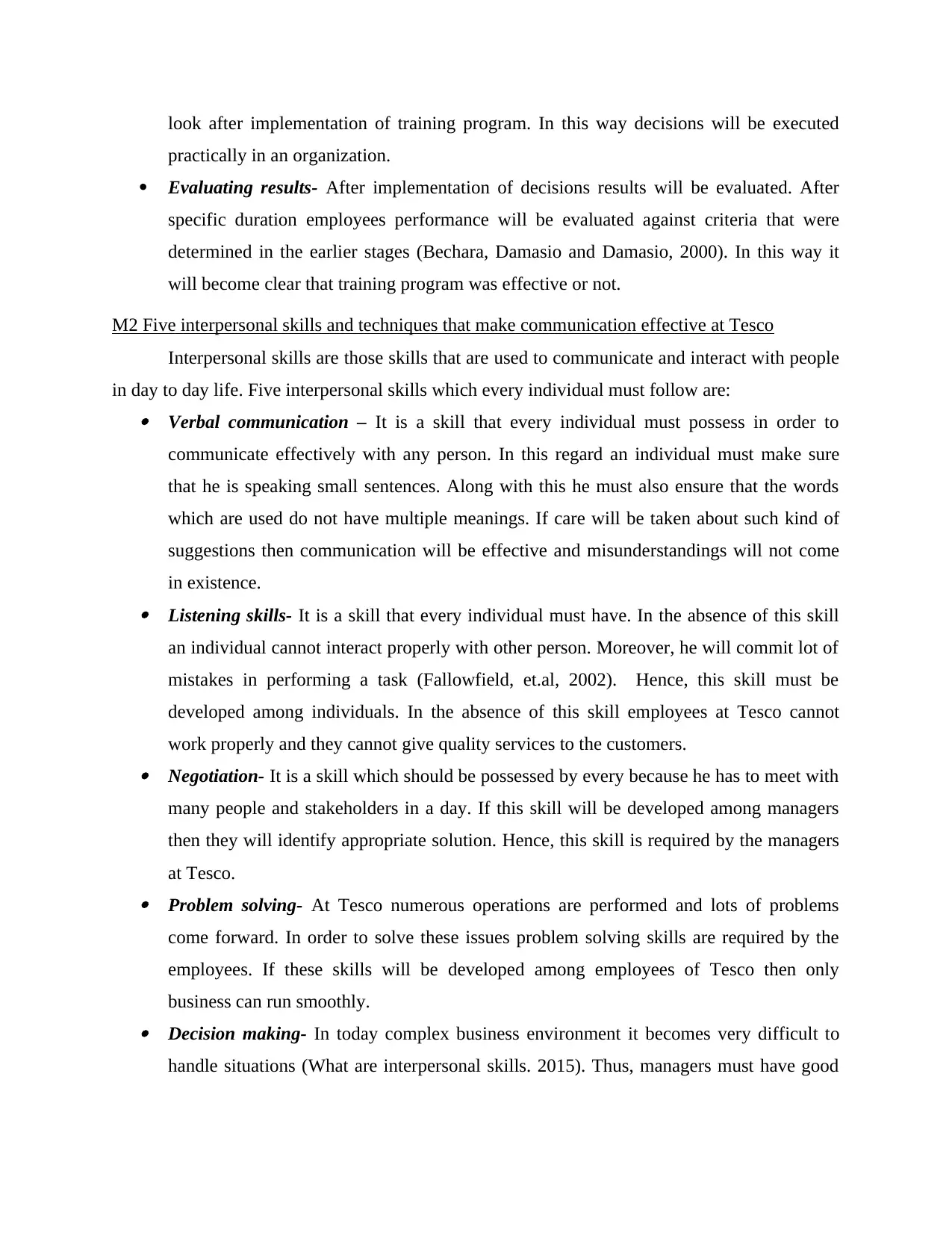
look after implementation of training program. In this way decisions will be executed
practically in an organization.
Evaluating results- After implementation of decisions results will be evaluated. After
specific duration employees performance will be evaluated against criteria that were
determined in the earlier stages (Bechara, Damasio and Damasio, 2000). In this way it
will become clear that training program was effective or not.
M2 Five interpersonal skills and techniques that make communication effective at Tesco
Interpersonal skills are those skills that are used to communicate and interact with people
in day to day life. Five interpersonal skills which every individual must follow are: Verbal communication – It is a skill that every individual must possess in order to
communicate effectively with any person. In this regard an individual must make sure
that he is speaking small sentences. Along with this he must also ensure that the words
which are used do not have multiple meanings. If care will be taken about such kind of
suggestions then communication will be effective and misunderstandings will not come
in existence. Listening skills- It is a skill that every individual must have. In the absence of this skill
an individual cannot interact properly with other person. Moreover, he will commit lot of
mistakes in performing a task (Fallowfield, et.al, 2002). Hence, this skill must be
developed among individuals. In the absence of this skill employees at Tesco cannot
work properly and they cannot give quality services to the customers. Negotiation- It is a skill which should be possessed by every because he has to meet with
many people and stakeholders in a day. If this skill will be developed among managers
then they will identify appropriate solution. Hence, this skill is required by the managers
at Tesco. Problem solving- At Tesco numerous operations are performed and lots of problems
come forward. In order to solve these issues problem solving skills are required by the
employees. If these skills will be developed among employees of Tesco then only
business can run smoothly. Decision making- In today complex business environment it becomes very difficult to
handle situations (What are interpersonal skills. 2015). Thus, managers must have good
practically in an organization.
Evaluating results- After implementation of decisions results will be evaluated. After
specific duration employees performance will be evaluated against criteria that were
determined in the earlier stages (Bechara, Damasio and Damasio, 2000). In this way it
will become clear that training program was effective or not.
M2 Five interpersonal skills and techniques that make communication effective at Tesco
Interpersonal skills are those skills that are used to communicate and interact with people
in day to day life. Five interpersonal skills which every individual must follow are: Verbal communication – It is a skill that every individual must possess in order to
communicate effectively with any person. In this regard an individual must make sure
that he is speaking small sentences. Along with this he must also ensure that the words
which are used do not have multiple meanings. If care will be taken about such kind of
suggestions then communication will be effective and misunderstandings will not come
in existence. Listening skills- It is a skill that every individual must have. In the absence of this skill
an individual cannot interact properly with other person. Moreover, he will commit lot of
mistakes in performing a task (Fallowfield, et.al, 2002). Hence, this skill must be
developed among individuals. In the absence of this skill employees at Tesco cannot
work properly and they cannot give quality services to the customers. Negotiation- It is a skill which should be possessed by every because he has to meet with
many people and stakeholders in a day. If this skill will be developed among managers
then they will identify appropriate solution. Hence, this skill is required by the managers
at Tesco. Problem solving- At Tesco numerous operations are performed and lots of problems
come forward. In order to solve these issues problem solving skills are required by the
employees. If these skills will be developed among employees of Tesco then only
business can run smoothly. Decision making- In today complex business environment it becomes very difficult to
handle situations (What are interpersonal skills. 2015). Thus, managers must have good
Paraphrase This Document
Need a fresh take? Get an instant paraphrase of this document with our AI Paraphraser
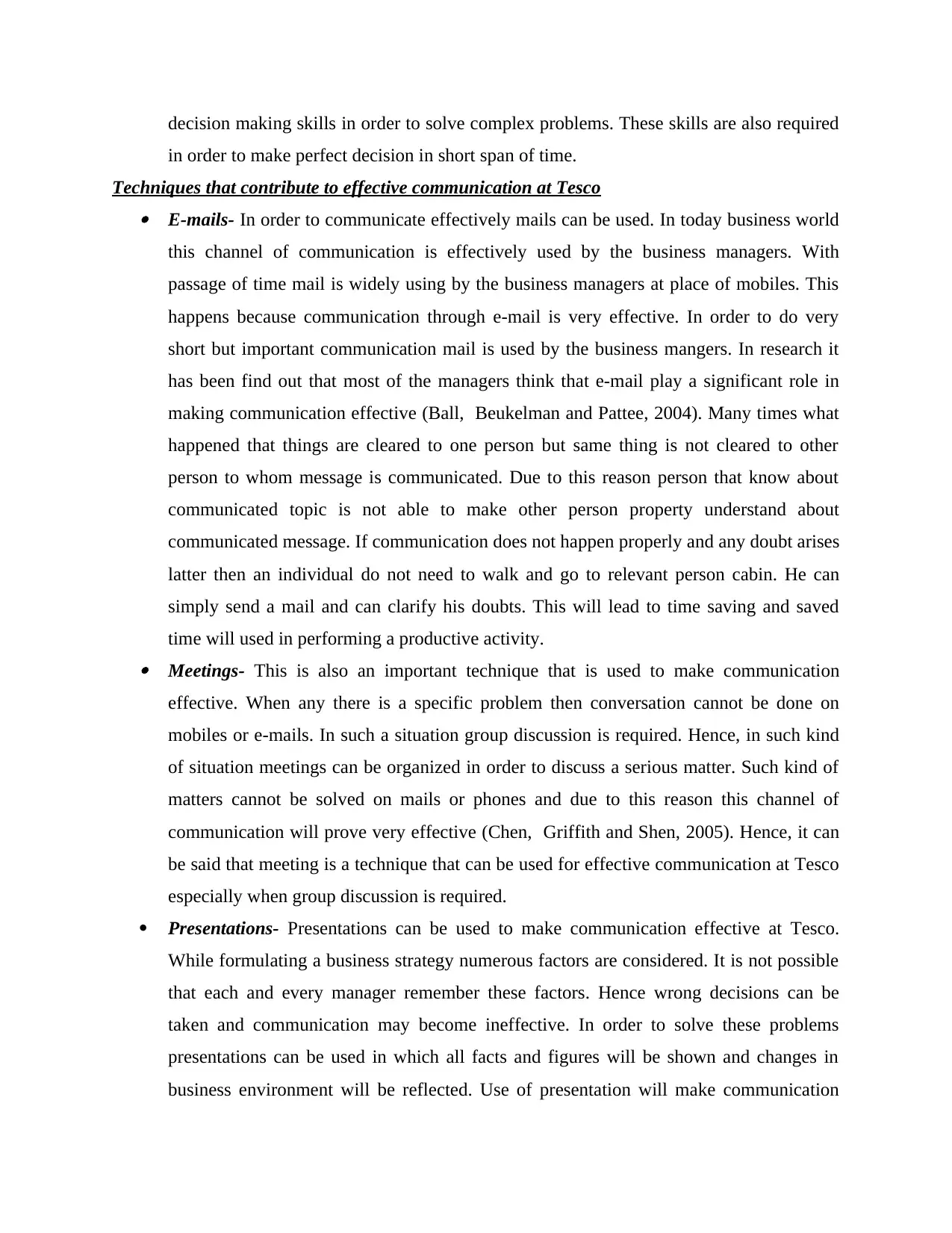
decision making skills in order to solve complex problems. These skills are also required
in order to make perfect decision in short span of time.
Techniques that contribute to effective communication at Tesco E-mails- In order to communicate effectively mails can be used. In today business world
this channel of communication is effectively used by the business managers. With
passage of time mail is widely using by the business managers at place of mobiles. This
happens because communication through e-mail is very effective. In order to do very
short but important communication mail is used by the business mangers. In research it
has been find out that most of the managers think that e-mail play a significant role in
making communication effective (Ball, Beukelman and Pattee, 2004). Many times what
happened that things are cleared to one person but same thing is not cleared to other
person to whom message is communicated. Due to this reason person that know about
communicated topic is not able to make other person property understand about
communicated message. If communication does not happen properly and any doubt arises
latter then an individual do not need to walk and go to relevant person cabin. He can
simply send a mail and can clarify his doubts. This will lead to time saving and saved
time will used in performing a productive activity. Meetings- This is also an important technique that is used to make communication
effective. When any there is a specific problem then conversation cannot be done on
mobiles or e-mails. In such a situation group discussion is required. Hence, in such kind
of situation meetings can be organized in order to discuss a serious matter. Such kind of
matters cannot be solved on mails or phones and due to this reason this channel of
communication will prove very effective (Chen, Griffith and Shen, 2005). Hence, it can
be said that meeting is a technique that can be used for effective communication at Tesco
especially when group discussion is required.
Presentations- Presentations can be used to make communication effective at Tesco.
While formulating a business strategy numerous factors are considered. It is not possible
that each and every manager remember these factors. Hence wrong decisions can be
taken and communication may become ineffective. In order to solve these problems
presentations can be used in which all facts and figures will be shown and changes in
business environment will be reflected. Use of presentation will make communication
in order to make perfect decision in short span of time.
Techniques that contribute to effective communication at Tesco E-mails- In order to communicate effectively mails can be used. In today business world
this channel of communication is effectively used by the business managers. With
passage of time mail is widely using by the business managers at place of mobiles. This
happens because communication through e-mail is very effective. In order to do very
short but important communication mail is used by the business mangers. In research it
has been find out that most of the managers think that e-mail play a significant role in
making communication effective (Ball, Beukelman and Pattee, 2004). Many times what
happened that things are cleared to one person but same thing is not cleared to other
person to whom message is communicated. Due to this reason person that know about
communicated topic is not able to make other person property understand about
communicated message. If communication does not happen properly and any doubt arises
latter then an individual do not need to walk and go to relevant person cabin. He can
simply send a mail and can clarify his doubts. This will lead to time saving and saved
time will used in performing a productive activity. Meetings- This is also an important technique that is used to make communication
effective. When any there is a specific problem then conversation cannot be done on
mobiles or e-mails. In such a situation group discussion is required. Hence, in such kind
of situation meetings can be organized in order to discuss a serious matter. Such kind of
matters cannot be solved on mails or phones and due to this reason this channel of
communication will prove very effective (Chen, Griffith and Shen, 2005). Hence, it can
be said that meeting is a technique that can be used for effective communication at Tesco
especially when group discussion is required.
Presentations- Presentations can be used to make communication effective at Tesco.
While formulating a business strategy numerous factors are considered. It is not possible
that each and every manager remember these factors. Hence wrong decisions can be
taken and communication may become ineffective. In order to solve these problems
presentations can be used in which all facts and figures will be shown and changes in
business environment will be reflected. Use of presentation will make communication
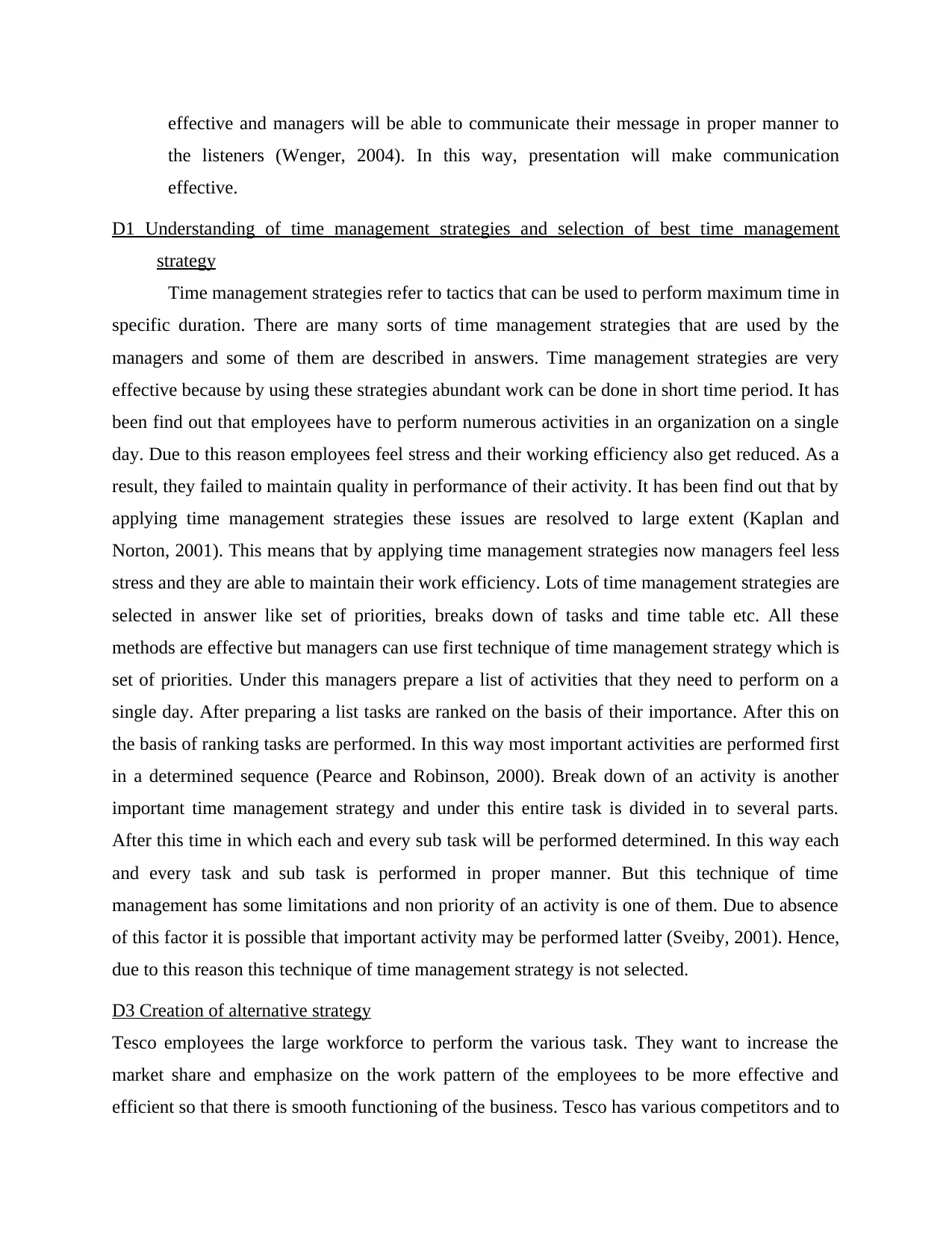
effective and managers will be able to communicate their message in proper manner to
the listeners (Wenger, 2004). In this way, presentation will make communication
effective.
D1 Understanding of time management strategies and selection of best time management
strategy
Time management strategies refer to tactics that can be used to perform maximum time in
specific duration. There are many sorts of time management strategies that are used by the
managers and some of them are described in answers. Time management strategies are very
effective because by using these strategies abundant work can be done in short time period. It has
been find out that employees have to perform numerous activities in an organization on a single
day. Due to this reason employees feel stress and their working efficiency also get reduced. As a
result, they failed to maintain quality in performance of their activity. It has been find out that by
applying time management strategies these issues are resolved to large extent (Kaplan and
Norton, 2001). This means that by applying time management strategies now managers feel less
stress and they are able to maintain their work efficiency. Lots of time management strategies are
selected in answer like set of priorities, breaks down of tasks and time table etc. All these
methods are effective but managers can use first technique of time management strategy which is
set of priorities. Under this managers prepare a list of activities that they need to perform on a
single day. After preparing a list tasks are ranked on the basis of their importance. After this on
the basis of ranking tasks are performed. In this way most important activities are performed first
in a determined sequence (Pearce and Robinson, 2000). Break down of an activity is another
important time management strategy and under this entire task is divided in to several parts.
After this time in which each and every sub task will be performed determined. In this way each
and every task and sub task is performed in proper manner. But this technique of time
management has some limitations and non priority of an activity is one of them. Due to absence
of this factor it is possible that important activity may be performed latter (Sveiby, 2001). Hence,
due to this reason this technique of time management strategy is not selected.
D3 Creation of alternative strategy
Tesco employees the large workforce to perform the various task. They want to increase the
market share and emphasize on the work pattern of the employees to be more effective and
efficient so that there is smooth functioning of the business. Tesco has various competitors and to
the listeners (Wenger, 2004). In this way, presentation will make communication
effective.
D1 Understanding of time management strategies and selection of best time management
strategy
Time management strategies refer to tactics that can be used to perform maximum time in
specific duration. There are many sorts of time management strategies that are used by the
managers and some of them are described in answers. Time management strategies are very
effective because by using these strategies abundant work can be done in short time period. It has
been find out that employees have to perform numerous activities in an organization on a single
day. Due to this reason employees feel stress and their working efficiency also get reduced. As a
result, they failed to maintain quality in performance of their activity. It has been find out that by
applying time management strategies these issues are resolved to large extent (Kaplan and
Norton, 2001). This means that by applying time management strategies now managers feel less
stress and they are able to maintain their work efficiency. Lots of time management strategies are
selected in answer like set of priorities, breaks down of tasks and time table etc. All these
methods are effective but managers can use first technique of time management strategy which is
set of priorities. Under this managers prepare a list of activities that they need to perform on a
single day. After preparing a list tasks are ranked on the basis of their importance. After this on
the basis of ranking tasks are performed. In this way most important activities are performed first
in a determined sequence (Pearce and Robinson, 2000). Break down of an activity is another
important time management strategy and under this entire task is divided in to several parts.
After this time in which each and every sub task will be performed determined. In this way each
and every task and sub task is performed in proper manner. But this technique of time
management has some limitations and non priority of an activity is one of them. Due to absence
of this factor it is possible that important activity may be performed latter (Sveiby, 2001). Hence,
due to this reason this technique of time management strategy is not selected.
D3 Creation of alternative strategy
Tesco employees the large workforce to perform the various task. They want to increase the
market share and emphasize on the work pattern of the employees to be more effective and
efficient so that there is smooth functioning of the business. Tesco has various competitors and to
⊘ This is a preview!⊘
Do you want full access?
Subscribe today to unlock all pages.

Trusted by 1+ million students worldwide
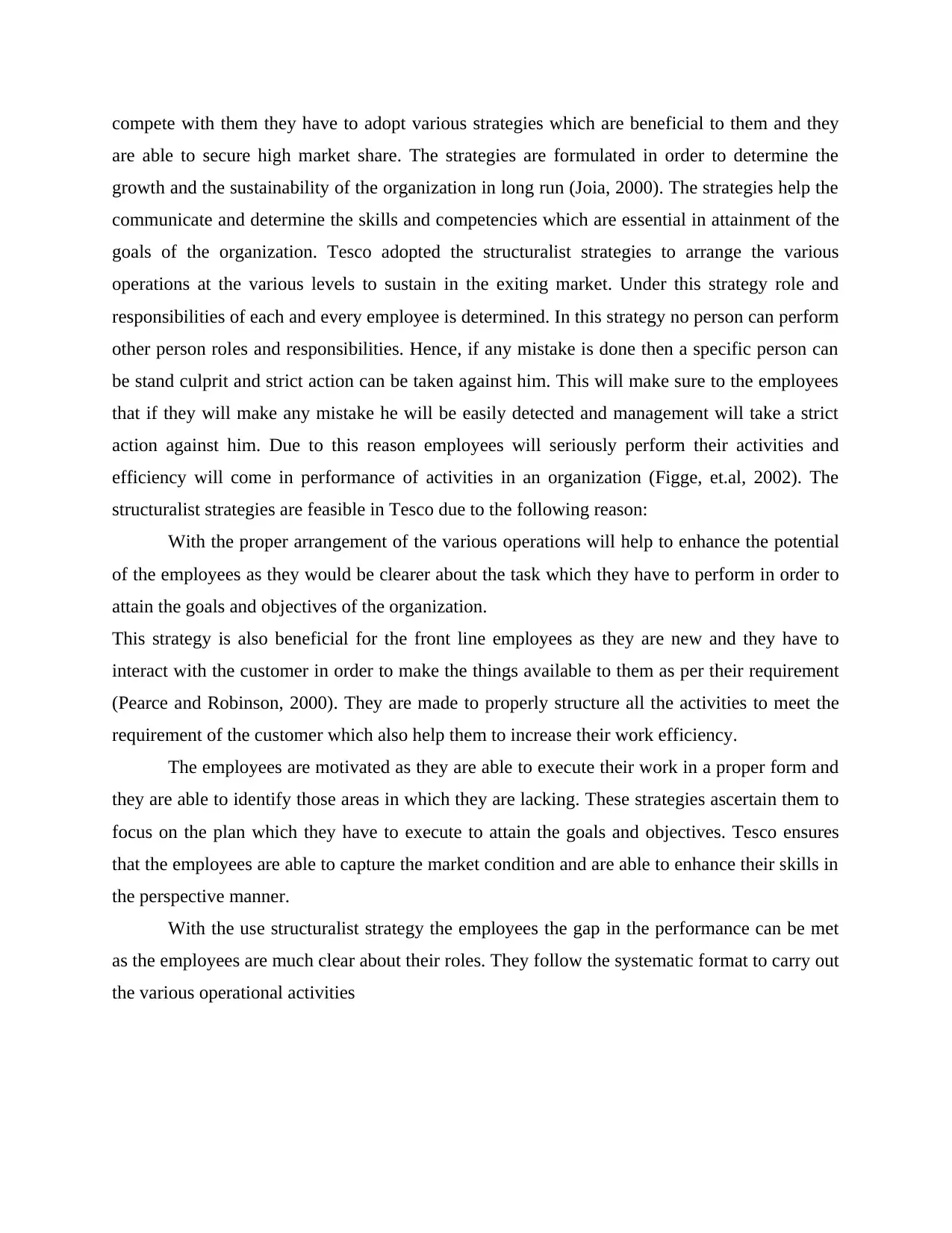
compete with them they have to adopt various strategies which are beneficial to them and they
are able to secure high market share. The strategies are formulated in order to determine the
growth and the sustainability of the organization in long run (Joia, 2000). The strategies help the
communicate and determine the skills and competencies which are essential in attainment of the
goals of the organization. Tesco adopted the structuralist strategies to arrange the various
operations at the various levels to sustain in the exiting market. Under this strategy role and
responsibilities of each and every employee is determined. In this strategy no person can perform
other person roles and responsibilities. Hence, if any mistake is done then a specific person can
be stand culprit and strict action can be taken against him. This will make sure to the employees
that if they will make any mistake he will be easily detected and management will take a strict
action against him. Due to this reason employees will seriously perform their activities and
efficiency will come in performance of activities in an organization (Figge, et.al, 2002). The
structuralist strategies are feasible in Tesco due to the following reason:
With the proper arrangement of the various operations will help to enhance the potential
of the employees as they would be clearer about the task which they have to perform in order to
attain the goals and objectives of the organization.
This strategy is also beneficial for the front line employees as they are new and they have to
interact with the customer in order to make the things available to them as per their requirement
(Pearce and Robinson, 2000). They are made to properly structure all the activities to meet the
requirement of the customer which also help them to increase their work efficiency.
The employees are motivated as they are able to execute their work in a proper form and
they are able to identify those areas in which they are lacking. These strategies ascertain them to
focus on the plan which they have to execute to attain the goals and objectives. Tesco ensures
that the employees are able to capture the market condition and are able to enhance their skills in
the perspective manner.
With the use structuralist strategy the employees the gap in the performance can be met
as the employees are much clear about their roles. They follow the systematic format to carry out
the various operational activities
are able to secure high market share. The strategies are formulated in order to determine the
growth and the sustainability of the organization in long run (Joia, 2000). The strategies help the
communicate and determine the skills and competencies which are essential in attainment of the
goals of the organization. Tesco adopted the structuralist strategies to arrange the various
operations at the various levels to sustain in the exiting market. Under this strategy role and
responsibilities of each and every employee is determined. In this strategy no person can perform
other person roles and responsibilities. Hence, if any mistake is done then a specific person can
be stand culprit and strict action can be taken against him. This will make sure to the employees
that if they will make any mistake he will be easily detected and management will take a strict
action against him. Due to this reason employees will seriously perform their activities and
efficiency will come in performance of activities in an organization (Figge, et.al, 2002). The
structuralist strategies are feasible in Tesco due to the following reason:
With the proper arrangement of the various operations will help to enhance the potential
of the employees as they would be clearer about the task which they have to perform in order to
attain the goals and objectives of the organization.
This strategy is also beneficial for the front line employees as they are new and they have to
interact with the customer in order to make the things available to them as per their requirement
(Pearce and Robinson, 2000). They are made to properly structure all the activities to meet the
requirement of the customer which also help them to increase their work efficiency.
The employees are motivated as they are able to execute their work in a proper form and
they are able to identify those areas in which they are lacking. These strategies ascertain them to
focus on the plan which they have to execute to attain the goals and objectives. Tesco ensures
that the employees are able to capture the market condition and are able to enhance their skills in
the perspective manner.
With the use structuralist strategy the employees the gap in the performance can be met
as the employees are much clear about their roles. They follow the systematic format to carry out
the various operational activities
Paraphrase This Document
Need a fresh take? Get an instant paraphrase of this document with our AI Paraphraser
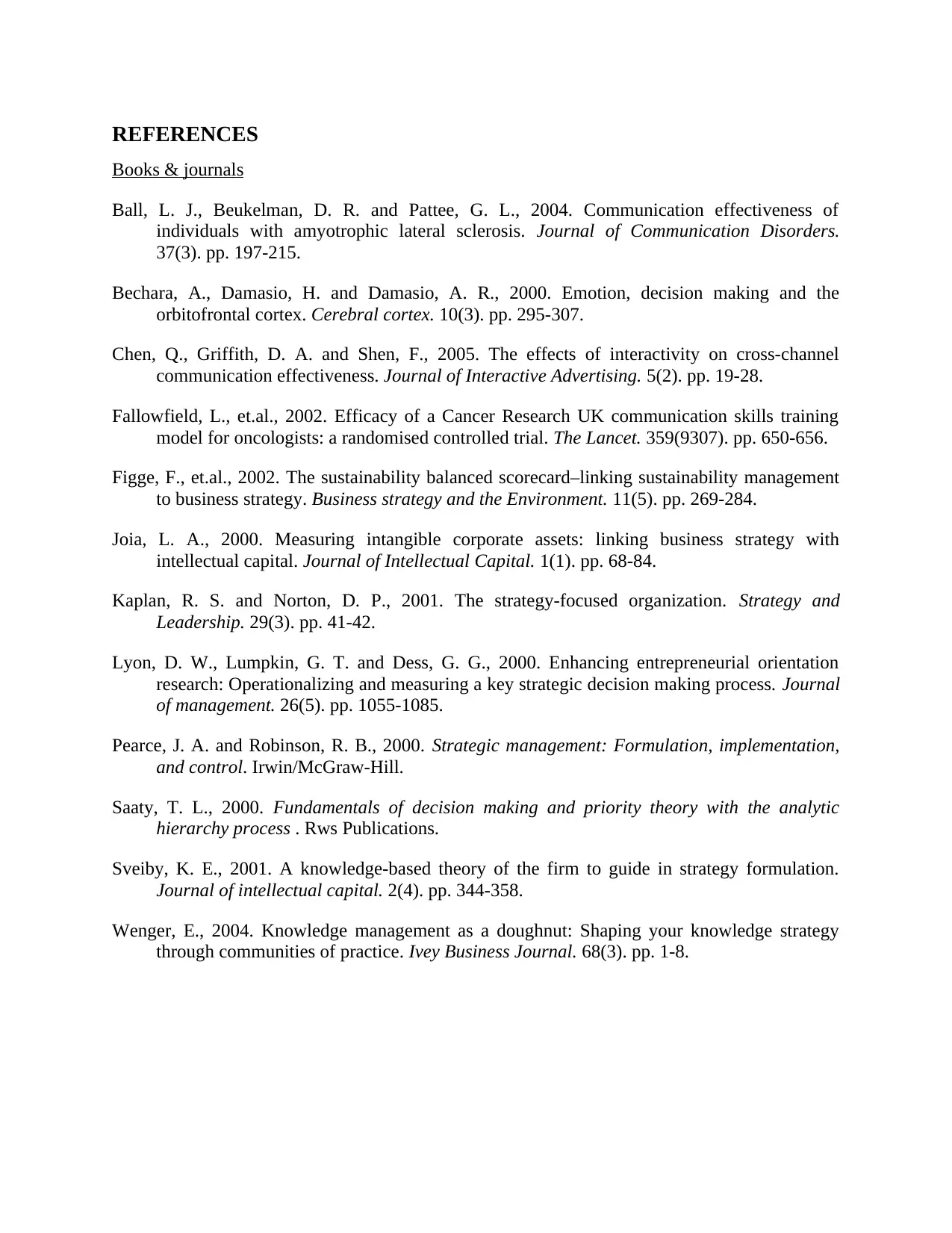
REFERENCES
Books & journals
Ball, L. J., Beukelman, D. R. and Pattee, G. L., 2004. Communication effectiveness of
individuals with amyotrophic lateral sclerosis. Journal of Communication Disorders.
37(3). pp. 197-215.
Bechara, A., Damasio, H. and Damasio, A. R., 2000. Emotion, decision making and the
orbitofrontal cortex. Cerebral cortex. 10(3). pp. 295-307.
Chen, Q., Griffith, D. A. and Shen, F., 2005. The effects of interactivity on cross-channel
communication effectiveness. Journal of Interactive Advertising. 5(2). pp. 19-28.
Fallowfield, L., et.al., 2002. Efficacy of a Cancer Research UK communication skills training
model for oncologists: a randomised controlled trial. The Lancet. 359(9307). pp. 650-656.
Figge, F., et.al., 2002. The sustainability balanced scorecard–linking sustainability management
to business strategy. Business strategy and the Environment. 11(5). pp. 269-284.
Joia, L. A., 2000. Measuring intangible corporate assets: linking business strategy with
intellectual capital. Journal of Intellectual Capital. 1(1). pp. 68-84.
Kaplan, R. S. and Norton, D. P., 2001. The strategy-focused organization. Strategy and
Leadership. 29(3). pp. 41-42.
Lyon, D. W., Lumpkin, G. T. and Dess, G. G., 2000. Enhancing entrepreneurial orientation
research: Operationalizing and measuring a key strategic decision making process. Journal
of management. 26(5). pp. 1055-1085.
Pearce, J. A. and Robinson, R. B., 2000. Strategic management: Formulation, implementation,
and control. Irwin/McGraw-Hill.
Saaty, T. L., 2000. Fundamentals of decision making and priority theory with the analytic
hierarchy process . Rws Publications.
Sveiby, K. E., 2001. A knowledge-based theory of the firm to guide in strategy formulation.
Journal of intellectual capital. 2(4). pp. 344-358.
Wenger, E., 2004. Knowledge management as a doughnut: Shaping your knowledge strategy
through communities of practice. Ivey Business Journal. 68(3). pp. 1-8.
Books & journals
Ball, L. J., Beukelman, D. R. and Pattee, G. L., 2004. Communication effectiveness of
individuals with amyotrophic lateral sclerosis. Journal of Communication Disorders.
37(3). pp. 197-215.
Bechara, A., Damasio, H. and Damasio, A. R., 2000. Emotion, decision making and the
orbitofrontal cortex. Cerebral cortex. 10(3). pp. 295-307.
Chen, Q., Griffith, D. A. and Shen, F., 2005. The effects of interactivity on cross-channel
communication effectiveness. Journal of Interactive Advertising. 5(2). pp. 19-28.
Fallowfield, L., et.al., 2002. Efficacy of a Cancer Research UK communication skills training
model for oncologists: a randomised controlled trial. The Lancet. 359(9307). pp. 650-656.
Figge, F., et.al., 2002. The sustainability balanced scorecard–linking sustainability management
to business strategy. Business strategy and the Environment. 11(5). pp. 269-284.
Joia, L. A., 2000. Measuring intangible corporate assets: linking business strategy with
intellectual capital. Journal of Intellectual Capital. 1(1). pp. 68-84.
Kaplan, R. S. and Norton, D. P., 2001. The strategy-focused organization. Strategy and
Leadership. 29(3). pp. 41-42.
Lyon, D. W., Lumpkin, G. T. and Dess, G. G., 2000. Enhancing entrepreneurial orientation
research: Operationalizing and measuring a key strategic decision making process. Journal
of management. 26(5). pp. 1055-1085.
Pearce, J. A. and Robinson, R. B., 2000. Strategic management: Formulation, implementation,
and control. Irwin/McGraw-Hill.
Saaty, T. L., 2000. Fundamentals of decision making and priority theory with the analytic
hierarchy process . Rws Publications.
Sveiby, K. E., 2001. A knowledge-based theory of the firm to guide in strategy formulation.
Journal of intellectual capital. 2(4). pp. 344-358.
Wenger, E., 2004. Knowledge management as a doughnut: Shaping your knowledge strategy
through communities of practice. Ivey Business Journal. 68(3). pp. 1-8.

Online
What are interpersonal skills, 2015. [Online]. Available through: <
http://www.skillsyouneed.com/interpersonal-skills.html>. [Accessed on 21st November
2015].
What are interpersonal skills, 2015. [Online]. Available through: <
http://www.skillsyouneed.com/interpersonal-skills.html>. [Accessed on 21st November
2015].
⊘ This is a preview!⊘
Do you want full access?
Subscribe today to unlock all pages.

Trusted by 1+ million students worldwide

1
1 out of 10
Related Documents
Your All-in-One AI-Powered Toolkit for Academic Success.
+13062052269
info@desklib.com
Available 24*7 on WhatsApp / Email
![[object Object]](/_next/static/media/star-bottom.7253800d.svg)
Unlock your academic potential
Copyright © 2020–2025 A2Z Services. All Rights Reserved. Developed and managed by ZUCOL.



